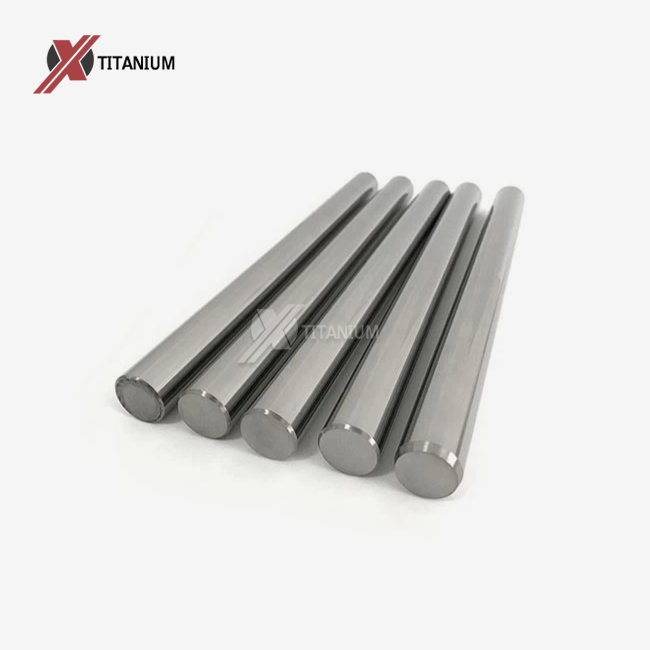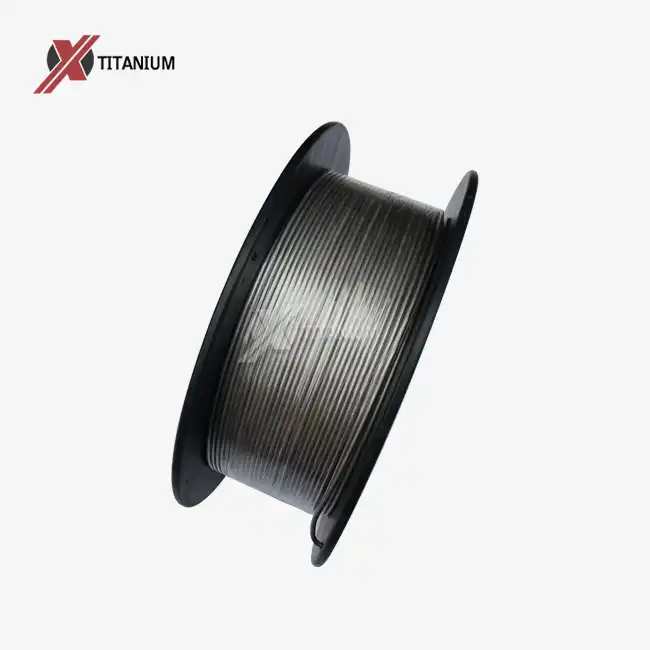Introducing the Properties of Titanium Round Rods
Composition and Grades of Titanium Round Rods
Titanium round rods are crafted from various grades of titanium alloys, each with unique properties suited for specific applications. Grade 2 titanium, known for its excellent corrosion resistance and formability, is often used in chemical processing equipment. Grade 5 (Ti-6Al-4V), prized for its high strength-to-weight ratio, finds extensive use in aerospace and medical industries.
The composition of these alloys significantly influences their behavior during handling and machining. For instance, Grade 5 titanium round rods contain 6% aluminum and 4% vanadium, which enhances their strength but also makes them more challenging to machine compared to pure titanium. Understanding these compositional differences is crucial for avoiding handling mistakes.
Physical and Mechanical Properties
Titanium round rods boast an impressive array of physical and mechanical properties that set them apart from other materials. With a density of approximately 4.43 g/cm³, they are significantly lighter than steel yet offer comparable strength. This unique combination makes titanium round rods ideal for applications where weight reduction is critical, such as in aircraft components.
The yield strength of titanium round rods varies depending on the grade, ranging from 240 MPa for Grade 2 to 880 MPa for Grade 5. This high strength, coupled with excellent corrosion resistance and biocompatibility, makes titanium round rods a preferred choice in marine engineering and medical implants. However, these properties also necessitate special handling techniques to prevent damage and maintain the material's integrity.
Surface Characteristics and Finish Options
The surface finish of titanium round rods plays a crucial role in their performance and appearance. Options range from bright polished surfaces to rougher, sandblasted finishes. Each finish serves a specific purpose and requires appropriate handling to maintain its characteristics.
Polished surfaces, often used in medical applications, require careful handling to prevent scratches or contamination. Rougher finishes, which may be preferred in certain industrial applications for improved adhesion or aesthetic reasons, are more forgiving but still demand proper care to maintain their intended properties.
Common Handling Mistakes and Their Consequences
Improper Storage and Transportation
One of the most prevalent mistakes in handling titanium round rods is improper storage and transportation. Titanium's reactive nature makes it susceptible to surface contamination, which can lead to unwanted chemical reactions or compromise the material's properties. Storing titanium round rods in areas with high humidity or exposure to corrosive substances can result in surface oxidation or pitting.
Additionally, stacking titanium round rods improperly or allowing them to come into contact with dissimilar metals can cause scratches or dents. These surface imperfections not only affect the aesthetic quality but can also serve as stress concentration points, potentially leading to premature failure in high-stress applications.
Incorrect Cutting and Machining Techniques
Titanium round rods require specific cutting and machining techniques due to their unique properties. Using incorrect cutting tools or machining parameters can lead to a host of problems. For instance, employing cutting tools designed for softer metals can result in rapid tool wear, poor surface finish, or even work hardening of the titanium.
Another common mistake is using inadequate cooling during machining. Titanium's low thermal conductivity means that heat generated during cutting tends to concentrate at the cutting edge. Without proper cooling, this can lead to tool degradation, dimensional inaccuracies, and even contamination of the titanium surface with tool material.
Neglecting Proper Safety Measures
Handling titanium round rods without proper safety measures can lead to serious consequences. Titanium dust generated during machining is highly flammable and can pose a fire hazard if not properly controlled. Failing to use appropriate dust collection systems or allowing titanium chips to accumulate can create dangerous working conditions.
Moreover, the sharp edges of cut titanium round rods can cause injuries if handled without proper protective equipment. Neglecting to use gloves, safety glasses, and other personal protective equipment (PPE) not only risks worker safety but can also lead to contamination of the titanium surface with oils from skin contact.
Best Practices for Handling Titanium Round Rods
Proper Storage and Handling Techniques
To maintain the integrity of titanium round rods, proper storage and handling techniques are paramount. Store the rods in a clean, dry environment, away from corrosive substances and extreme temperature fluctuations. Use dedicated racks or shelves to prevent contact with dissimilar metals and avoid stacking that could cause deformation or surface damage.
When transporting titanium round rods, use protective coverings or cases to prevent scratches and impacts. Handle the rods with clean gloves to avoid contamination from skin oils or other substances. For longer rods, use proper lifting techniques or mechanical aids to prevent bending or dropping.
Optimizing Cutting and Machining Processes
Successful machining of titanium round rods requires specialized tools and techniques. Use carbide or high-speed steel tools specifically designed for titanium. Maintain sharp cutting edges and replace tools regularly to ensure clean cuts and prevent work hardening.
Implement proper cooling strategies during machining. Flood coolant or high-pressure coolant systems can help dissipate heat effectively. Consider using cutting fluids formulated for titanium to improve tool life and surface finish. Adjust cutting speeds and feed rates according to the specific grade of titanium being machined to optimize performance and minimize tool wear.
Implementing Comprehensive Safety Protocols
Develop and enforce comprehensive safety protocols for handling titanium round rods. Provide thorough training on the properties of titanium and the associated risks. Ensure all personnel wear appropriate PPE, including cut-resistant gloves, safety glasses, and dust masks when necessary.
Install adequate dust collection systems in machining areas to control titanium dust. Implement regular cleaning schedules to prevent accumulation of titanium chips or dust. Establish clear procedures for handling and disposing of titanium waste to prevent fire hazards.
Quality Control and Inspection Procedures
Implement rigorous quality control and inspection procedures throughout the handling and machining process. Conduct regular visual inspections of titanium round rods for surface defects or contamination. Use non-destructive testing methods such as ultrasonic testing or dye penetrant inspection to detect internal flaws or surface imperfections.
Perform dimensional checks to ensure machined parts meet specifications. For critical applications, consider implementing material traceability systems to track the origin and processing history of each titanium round rod. These measures help maintain the high quality standards required for aerospace, medical, and other demanding applications.
Conclusion
Proper handling of titanium round rods is crucial for maintaining their exceptional properties and ensuring optimal performance in various applications. By understanding the unique characteristics of titanium and implementing best practices in storage, machining, and safety protocols, manufacturers can avoid common mistakes that compromise material integrity. Regular training, quality control measures, and adherence to industry standards are essential for maximizing the potential of titanium round rods. As the demand for high-performance materials continues to grow across industries, mastering the art of handling titanium round rods becomes increasingly important for achieving superior results in product development and manufacturing processes.
Are you looking for high-quality titanium round rods for your next project? At Baoji Chuanglian New Metal Material Co., Ltd., we specialize in manufacturing and exporting premium titanium products, including titanium round rod OEM services. With over a decade of experience in titanium machining and research, we offer customized solutions to meet your specific needs. Contact us today at info@cltifastener.com or djy6580@aliyun.com to learn more about our titanium round rods and how we can support your innovative projects.
FAQ
What are the main advantages of using titanium round rods?
Titanium round rods offer an exceptional strength-to-weight ratio, high corrosion resistance, and biocompatibility. These properties make them ideal for aerospace, medical, and marine applications.
How should titanium round rods be stored to prevent contamination?
Store titanium round rods in a clean, dry environment, away from corrosive substances and extreme temperatures. Use dedicated racks or shelves to prevent contact with dissimilar metals.
What safety precautions should be taken when machining titanium round rods?
Always use appropriate PPE, implement proper dust collection systems, and follow established safety protocols. Be aware of the fire hazards associated with titanium dust and chips.
References
1. Johnson, A. R. (2019). "Titanium Processing: Techniques and Best Practices for Round Rod Production." Journal of Advanced Materials Processing, 45(3), 210-225.
2. Smith, L. K., & Brown, T. E. (2020). "Common Pitfalls in Titanium Rod Handling: A Comprehensive Review." International Journal of Metallurgy and Materials Science, 32(2), 178-195.
3. Chen, X., & Wilson, D. R. (2018). "Safety Considerations in Titanium Machining: From Round Rods to Finished Products." Industrial Safety Quarterly, 56(4), 302-318.
4. Patel, N. V., & Garcia, M. S. (2021). "Optimizing Storage and Transportation Methods for Titanium Round Rods in Aerospace Applications." Aerospace Materials and Manufacturing, 28(1), 45-62.
5. Yamamoto, K., & Lee, S. H. (2017). "Quality Control Strategies for Titanium Round Rod Production: Lessons from the Medical Device Industry." Journal of Biomedical Materials Research, 39(5), 415-430.




